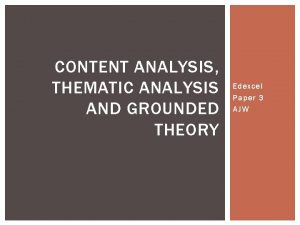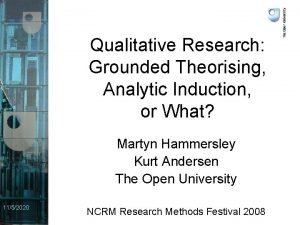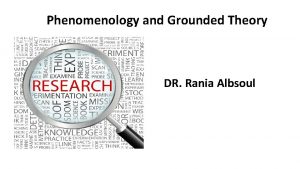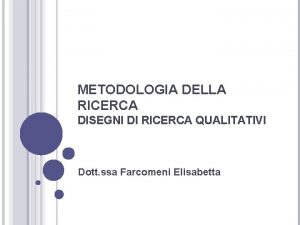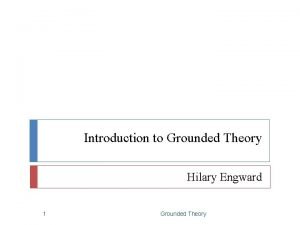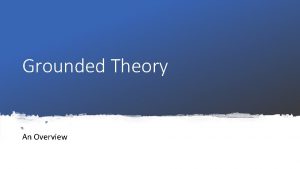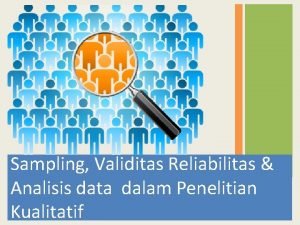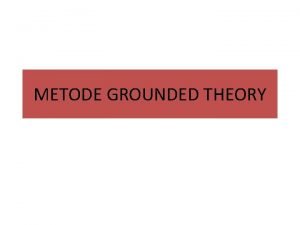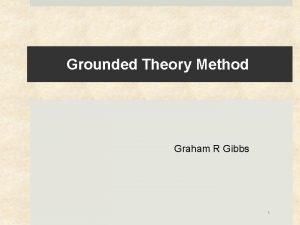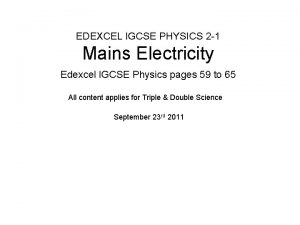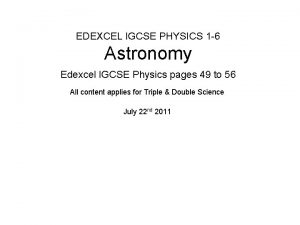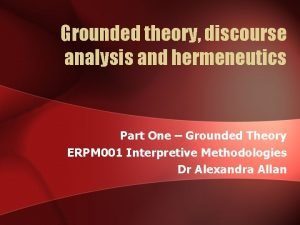CONTENT ANALYSIS THEMATIC ANALYSIS AND GROUNDED THEORY Edexcel















- Slides: 15

CONTENT ANALYSIS, THEMATIC ANALYSIS AND GROUNDED THEORY Edexcel Paper 3 AJW

WHAT IS CONTENT ANALYSIS? “a research method for the subjective interpretation of the content of text data through the systematic classification process of coding and identifying themes or patterns” (Hsieh & Shannon, 2005, p. 1278)

WHAT IS CONTENT ANALYSIS? “any qualitative data reduction and sense-making effort that takes a volume of qualitative material and attempts to identify core consistencies and meanings (Patton, 2002, p. 453)

WHAT IS CONTENT ANALYSIS? A way of analysing text-based, qualitative data for example newspaper articles, children’s books, interview transcripts and advert or film scripts. can be quantitative or qualitative: § Quantitative researchers may simply search for specific words, phrases or ideas in the data and count them up § Qualitative researchers will attempt to extract “meaning” through a search for themes in the data. § no counting up themes or statistical analysis § more sensible given that sampling is unlikely to have been random § far more likely to be purposive sampling, texts chosen specifically as known examples of the particular topic under investigation

DESCRIBING THE DATA: THEMATIC ANALYSIS Thematic analysis refers to a process by which a series of codes, categories and ultimately themes (underlying and recurring ideas) are derived from qualitative data Researcher will use a process of selective reduction; turning the full text into manageable units.

TWO WAYS TO DERIVE THEMES FROM DATA Hsieh and Shannon, (2015) §Conventional §Directed

CONVENTIONAL (FORMATIVE ANALYSIS) Involves a technique called close reading to turn every phrase from the text into a coding unit no starting point other than the data itself This is known as taking a bottom-up approach Researchers read over and over again until they have reached a point known as data saturation § they feel there are no further coding units to be found. This form of analysis is called an inductive content analysis as there is no theory being tested, an theory is emergent from the data itself.

DIRECTED (ALSO A FORMATIVE ANALYSIS) researchers start with some ideas in mind, from previous studies or theories, and this helps them to create the coding units in advance They then search for examples of these codes in the text very similar to a priori coding (remember: closed questions with forced choice answers in questionnaires and quantitative observation schedules with pre-determined behavioural checklists. ) This approach can be viewed as top-down, as we are seeing the data through a filter: that is pre-existing theory or research a way of unveiling which themes are apparent in the data we are analysing, from a set of themes which we have chosen prior to the analysis, based on previous research

INTERPRETING THE DATA; A STEP ON FROM THEMATIC ANALYSIS… Summative analysis Some researchers may choose to compare and interpret themes across different texts This can be done in a quantitative manner; § counting/tallying the frequency with which certain words, themes or ideas arise and making comparisons § This might result in a statistical analysis but this should only be completed if the sources of the data were chosen at random, which is unlikely

INTERPRETING THE DATA; A STEP ON FROM THEMATIC ANALYSIS…CONT’D This is known as manifest content analysis and is quantitative in nature. The researchers may then decide to go onto examine the latent content (underlying meanings) This is sometimes called relational analysis Researchers will look at the context in which the words/phrases are used and try to search for meaning; therefore it is more interpretative

LINKED CONCEPTS: GROUNDED THEORY very similar to qualitative summative content analysis uses the conventional approach a truly inductive, bottom- up approach to the collection and description of the data Results in a qualitative interpretation usually communicated visually through some sort of diagram

EVALUATING CONTENT ANALYSIS Qualitative content analysis is an interpretative technique and as such the meaning that is extracted may be considered subjective to the researcher Qualitative Researchers tend to use a language of their own and instead of asking whether the findings are valid, they will consider the trustworthiness and credibility of their findings.

TACKLING CREDIBILITY IN QUALITATIVE PSYCHOLOGY researcher triangulation: using more than one researcher to analyse the transcripts and compare the codes, categories and themes generated (the qualitative term for inter-rater reliability) checking the findings with the participants When data relate is from newspapers/films etc clearly there are no Pps as such, but a focus group could be organised to discuss the findings with consumers of these media products and see what they have to say about the trustworthiness of the outcomes highlighted by the researchers

REFLEXIVITY an important term in qualitative psychology! § personal reflexivity: the researcher considers possible bias linked to their own background § epistemological reflexivity; the researcher considers the way in which they chose to conduct the research and how this might have affected the outcomes

EXAMPLE OF A CONTENT ANALYSIS A good example of a content analysis from a case study of a lady whose brother has schizophrenia: http: //file. scirp. org/Html/98202038_28617. htm Further reading: https: //www. ischool. utexas. edu/~yanz/Conte nt_analysis. pdf qual_health_res-2005 -hsieh-1277 -88
 Difference between thematic and content analysis
Difference between thematic and content analysis Difference between thematic and content analysis
Difference between thematic and content analysis Analytic induction vs grounded theory
Analytic induction vs grounded theory Whats a thematic statement
Whats a thematic statement Grounded theory coding
Grounded theory coding Understanding qualitative research
Understanding qualitative research What is grounded theory in simple terms
What is grounded theory in simple terms Disegno di ricerca qualitativo
Disegno di ricerca qualitativo Theory method
Theory method Grounded theory qualitative research
Grounded theory qualitative research Phenomenology
Phenomenology Conditional matrix grounded theory
Conditional matrix grounded theory Holistic data collection
Holistic data collection Kathy charmaz
Kathy charmaz Validitas data kualitatif
Validitas data kualitatif Qualitative research grounded theory
Qualitative research grounded theory

